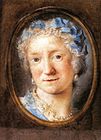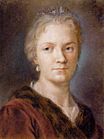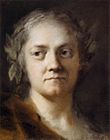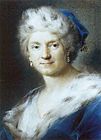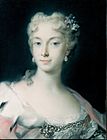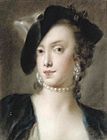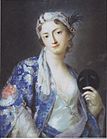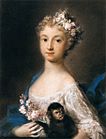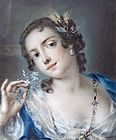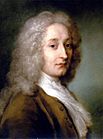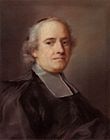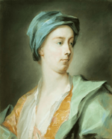Rosalba Carriera facts for kids
Quick facts for kids
Rosalba Carriera
|
|
|---|---|
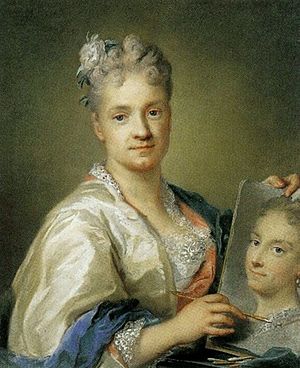
Self-portrait, 1715
|
|
| Born | 12 January 1673 Venice
|
| Died | 15 April 1757 (aged 84) Venice
|
| Nationality | Italian |
| Known for | Portrait painting |
| Movement | Rococo |
Rosalba Carriera (born January 12, 1673 – died April 15, 1757) was a famous Venetian painter. She was known for her beautiful Rococo style. When she was younger, Rosalba painted tiny portrait miniatures. Later, she became very famous for her pastel portraits. She helped make pastels popular in Europe during the 1700s. Rosalba Carriera is remembered as one of the most successful women artists ever.
Contents
About Rosalba Carriera
Rosalba Carriera was born in Venice. Her father, Andrea Carriera, was a lawyer. Her mother, Alba Foresti, made embroidery and lace. Rosalba learned lace-making and other crafts from her mother and sisters.
It's not fully known why she became an artist. One early writer, Pierre-Jean Mariette, thought it was because the lace business was not doing well. Rosalba might have needed a new way to support herself and her family.
People started using snuff, which gave Rosalba a chance. She began painting tiny pictures for the lids of snuff-boxes. She also made these miniatures as artworks on their own. She was one of the first artists to use ivory instead of vellum for her miniatures.
Soon, she also started painting portraits using pastels. Important visitors to Venice, like young noblemen on their "Grand Tour" and diplomats, wanted her artwork. Some of her early portraits include those of Maximilian II of Bavaria and Frederick IV of Denmark. She also painted August the Strong of Saxony, who bought many of her pastel works.
By 1700, Rosalba was already creating miniatures. By 1703, she finished her first pastel portraits. In 1704, she received a special title, Accademico di merito, from the Roman Accademia di San Luca. This title was usually given to painters who were not from Rome.
Working in Paris
Between 1720 and 1721, Rosalba Carriera worked in Paris, France. Her paintings were very popular there. In Paris, she stayed with Pierre Crozat, a famous art collector. She painted many important people, including Antoine Watteau, the King, and the Regent. She was even chosen to be a member of the French Academy.
Her brother-in-law, the painter Antonio Pellegrini, was also in Paris. He was married to Rosalba's sister, Angela. Pellegrini worked for John Law, a Scottish businessman, painting a ceiling in his new bank.
Rosalba's other sister, Giovanna, and her mother were also with her in France. Both sisters, especially Giovanna, helped Rosalba paint the many portraits she was asked to do. She took on a lot of work to support her family. Rosalba kept a diary of her 18 months in Paris. It was later published in 1793. She also wrote many letters, which have been published too.
Return to Venice
Rosalba's work in Paris helped shape the new art styles of the French court. Her art was no longer just for the monarchy. Her free, colorful, and charming style influenced the Rococo art movement. This style soon became very popular.
Even though she was very successful in Paris, Rosalba returned to her home in Venice in 1721. Later, she visited Modena, Parma, and Vienna with her sister Giovanna. Rulers and courts in these cities were very excited to see her work.
In 1730, Rosalba traveled to the royal court in Vienna, Austria. There, Holy Roman Emperor Charles VI became her supporter. The Emperor collected more than 150 of her pastel paintings. The Empress even took art lessons from Rosalba. The paintings she made in Vienna are now a big part of the collection at the Alte Meister Gallery in Dresden.
After her sister Giovanna died in 1738, Rosalba became very sad. She also started losing her eyesight a few years later. This might have been caused by painting tiny miniatures when she was young. She had two eye surgeries, but they didn't work, and she lost her vision completely. Rosalba lived longer than all her family members. She spent her last years in a small house in Venice and died at 84 years old.
How Rosalba Learned to Paint
Rosalba's mother taught her how to make lace. We don't have many records about how she learned to paint portraits. She might have studied with artists like Antonio Lazzari, Federico Benecovich, and Giuseppe Diamantini. She may also have worked with Antonio Balestra and copied his art. Some people think that the French painter Jean Steve encouraged her to paint miniatures on ivory for snuffbox lids. She might have also learned oil painting techniques from Diamantini.
Rosalba shared her skills with her sisters, Giovanna and Angela. Later in her life, she also taught female students like Marianna Carlevarijs, Margherita Terzi, and Felicità Sartori.
Rosalba's Impact on Art
Rosalba Carriera had a big influence on many artists. In 1720, she painted a portrait for King Louis XV. This painting helped change the style of art at the French court. It moved from a powerful, formal style to a more decorative one that was popular everywhere.
She also made an important change in art materials. She helped develop a way to bind colored chalk into sticks. This led to many more colors being available for pastels. It made pastels much more useful for artists.
The Rococo art style was sometimes criticized. But Rosalba Carriera played a very important part in making it popular in France and later in England. King George III of England was a big collector of her work.
Even with her fame, Rosalba is often seen as a "rare" woman artist and sometimes overlooked. When the Rococo style went out of fashion, Rosalba's name and her impact were sometimes forgotten. This was partly because she was a woman.
Rosalba's Artworks
Rosalba Carriera was the first female painter to start a new art style. The Rococo style used soft, pastel colors. It featured quick brush strokes, dancing lights, and gentle colors. It created a soft, elegant, and charming look in paintings.
She was known for using the side of white chalk to create a shimmering look. This helped her show the texture of lace and satin. She also used this technique to highlight faces and the soft, powdered hair in her portraits. Because of her, artists used this style for almost a hundred years.
Rosalba had many people who bought her art. Her earliest known pastel portrait is of the collector Anton Maria Zanetti (painted in 1700). He bought many of her works and told other collectors about her. Joseph Smith was another admirer who collected many of her paintings. King George III later bought these pieces in 1762. That collection included one of Rosalba's many self-portraits.
Her most famous self-portrait is in the Medici collection at the Uffizi Gallery in Florence. This painting was special because she didn't try to make herself look perfect, which was common at the time. Instead, she was honest in her painting. She showed herself with a larger nose, thin lips, and a deep dimple in her chin. In the painting, she holds a portrait of her sister and assistant, Giovanna, whom she was very close to.
Her self-portraits are different from what was expected of women artists back then. She aimed for a very natural look. For example, in her Self-Portrait as an Old Woman (1746), her eyes look a bit mismatched. This hints at the eye problems she had later in life.
Rosalba Carriera was mostly a portrait painter because it was her job. But she also created some allegorical pieces. These include ‘The Four Seasons’, ‘The Four Elements’, and ‘The Four Continents’'. These allegories showed beautiful, nymph-like women. They were lightly clothed and held symbols that represented the meaning of the artwork.
Gallery
-
Cardinal Melchior de Polignac
Rosalba's Legacy
Rosalba Carriera was best known for her new ways of using pastels. Before her, pastels were mostly used for quick drawings or sketches. She made pastels a serious art form for portraits. She also helped define the Rococo art style.
Rosalba Carriera is a character in the book The Laws of Time (2019) by Andrea Perego.
See also
 In Spanish: Rosalba Carriera para niños
In Spanish: Rosalba Carriera para niños



